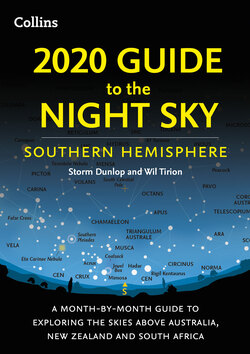Читать книгу 2020 Guide to the Night Sky Southern Hemisphere - Storm Dunlop - Страница 5
ОглавлениеTime Zones
The times of events in this book are given in Coordinated Universal Time (UTC), here abbreviated to Universal Time (UT). This time is equivalent to the time on the Greenwich meridian (GMT), and is used by astronomers around the world so that observations may be compared easily, without having to convert from local (zone) times. Universal Time is always given on a 24-hour clock (sometimes known as ‘military time’ or ‘Zulu’, ‘Z’). In many countries times are generally given as a.m. or p.m. and such times are shown on the charts showing the appearance of the sky for each month. Giving the times of individual events as a.m. or p.m. would be complex and confusing, so those times may need to be converted from UT.
Australia
Australian time zones are shown on this map. There are three: Australian Western Standard Time (AWST); Australian Central Standard Time (ACST); and Australian Eastern Standard Time (AEST). Some individual states (Western Australia, Northern Territory and Queensland) do not use daylight saving time (DST) during the summer months. To obtain local (zone) time from Universal Time (UT), add the hours shown in this table. If the result is greater than 24, subtract 24 hours. If the initial or subsequent result is less than 12:00, the zone time is a.m.; if greater, subtract 12 hours to get the time p.m. The dates when Daylight Saving Time begins and ends are shown on the individual calendars inside the book. At the time of writing, it is introduced on the first Sunday of October and ends on the first Sunday in April.
| Time zone | Winter | Summer | Time zone | Winter | Summer |
| Australia | Add hours shown to UT | Australian Capital Territory | 10:00 (AEST) | 11:00 (DST) | |
| Western Australia | 08:00 (AWST) | no DST | Victoria | 10:00 (AEST) | 11:00 (DST) |
| Northern Territory | 09:30 (ACST) | no DST | Tasmania | 10:00 (AEST) | 11:00 (DST) |
| Queensland | 10:00 (AEST) | no DST | |||
| South Australia | 09:30 (ACST) | 10:30 (DST) | New Zealand | 12:00 (NZST) | 13:00 (NZDT) |
| New South Wales | 10:00 (AEST) | 11:00 (DST) | South Africa | 02:00 (SAST) | no DST |
New Zealand
New Zealand uses a single time zone for the North and South Islands: New Zealand Standard Time (NZST) which is 12 hours ahead of UT. Daylight saving time (NZDT) is used in the summer, and begins on the last Sunday in September and ends on the first Sunday of April. (Note that it begins one week before the Australian start of Daylight Saving Time.) As for Australia, the hours shown above should be added to Universal Time (UT). If the result is greater than 24, subtract 24 hours. If the initial or subsequent result is less than 12:00, the zone time is a.m.; if greater, subtract 12 hours to get the time p.m. The dates when Daylight Saving Time begins and ends are shown on the individual calendars inside the book.
South Africa
South Africa uses a single time zone: South Africa Standard Time (SAST). This is two hours in advance of UT. Daylight Saving Time / Summer Time is not used. To obtain local (zone) time, add two hours to UT. If the result is greater than 24, subtract 24 hours. If the initial or subsequent result is less than 12:00, the zone time is a.m.; if greater, subtract 12 hours to get the time p.m.
